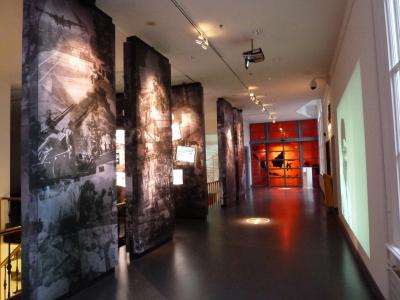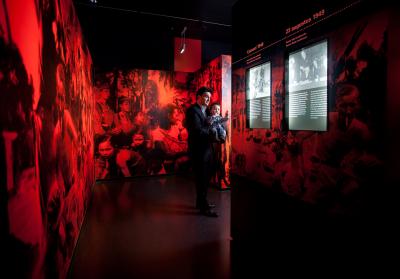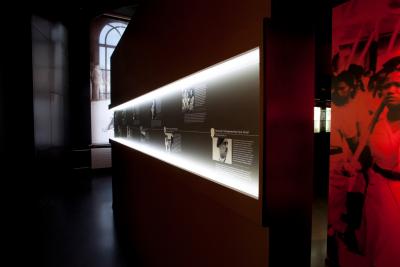Indies Remembrance: The Story of the Netherlands-Indies
On 16 August 2010, one day after the annual commemoration of the ending of the Second World War in the Pacific, the permanent exhibition The Story of the Netherlands-Indies (The Story of) was launched in the Centre of Indies Remembrance (IHC, Arnhem, The Netherlands). The IHC is a community based Centre of Remembrance set up for the heterogeneous group of postcolonial migrants who came to the Netherlands after Indonesia’s Independence (1945). The Indies-Dutch group consists mostly of “repatriates” of mixed Indonesian and European descent as well as their children and grandchildren born in the Netherlands. Established by the Dutch Ministry of Health, Welfare and Sport, the Centre of Indies Remembrance was founded after repeated calls from the Indies-Dutch community. As one of the four Centres of Remembrance of the Second World War in the Netherlands, this is the only one that focuses on the war in the Pacific.
The Story of the Netherlands-Indies is a mixed media exhibition, accommodated in Bronbeek, a home for elderly KNIL-veterans which includes a military museum. Developed by the Centre of Indies Remembrance (IHC) and the military museum Bronbeek together, The Story of narrates 350 years of Dutch colonialism in the Netherlands-Indies, merging military colonial history and Indies-Dutch remembrance of the colonial past. With few written explanations and captions, the exhibition rather works through image recognition, experience and emotion. It addresses the senses of its visitors by the use of sounds and a large quantity of visual material. This affect is also created by the emotions, by touch and by movement. The exhibition is set up in six, crowded rooms on the first floor and the audience has to cross a hall, climb the stairs and move from room to room while the visual, aural and tactile effects of the exhibition take effect.
Digitalization and photographic manipulation underline this ‘experience’ of the colonial past.
As the IHC does not own a photographic collection, photographs with specific documentary value have been acquired from individuals and other institutions to create The Story of. They are reproduced in various formats , are either blown up or cropped, and projected on walls and objects. There are slides which have paintings or films projected in the centre of the image, as well as huge red photographic collages covering the walls of a narrow, winding mace and small identity photos next to captions with personal memories. These individual memories run parallel to the chronological story-line that gathers politically important events.
Well-known, even iconic photographs are cropped or blown up in life-size representations. Often, only enlarged parts of “original” images are used as the background of a window, as if to extend narratives around objects on display or to hide possible stories.
Light also evokes a narrative effect: whilst the first three ‘colonial’ rooms are rather dark (also to protect the ‘real’ paintings), Room 5, representing the Indonesian Revolution, is illuminated by alarming reddish light, while Room 6 (New Grounds 1949-present) is bathed in cold neon light which refers to the cold-hearted bureaucratic reception of the Indies-Dutch migrants. Sound is another meaning-maker. Whereas most rooms have none or soft sounds, the audience will be startled by the loud sounds produced in Room 5 (Revolution 1945-1949).
The affect of the exhibition is, in other words, not the result of photographs that speak for themselves. The photographs work in a sensual network which is constituted through the exhibition as a whole. Through emotions and motions (moving from panel to window, from room to room, bending down to look at glass windows in the floor, turning corners, opening drawers), sounds, touch, very few written texts or explanations, and, particularly through an overwhelming presence of photographic images visitors will sense The Story of the Dutch Netherlands-Indie as a bodily experience. Although the IHC exhibition claims to tell ‘the’ story of the Netherlands-Indies, it contains, in fact, multiple stories. Even though it focuses on colonial life, and hides “difficult” histories, it nonetheless shows glimpses of some other uneasy memories such as Indonesian nationalism, enforced prostitution and the (military) use of violence. The contemporary set-up of the exhibition underlines this multiplicity. The mixed media display communicates in the first place that the colonial past refers to a dynamic narrative archive instead of to a closed era.
Yet, tensions emerged when the Indies Centre of Remembrance was housed in a military space. As a memorial space the Centre is sometimes pushed to the background in order to make way for military interests. As it takes the departure of the European community as it’s starting point, the exhibition is centred around the Second World War and the decolonization, including the Japanese Occupation and the Revolusi or War of Independence. Seen from this perspective, the exhibition mediates not only the entanglements of, but also the tensions between national memories saturated with the loss of the profitable and beloved colony and memories of Indies-Dutch migrants saturated with the loss of a birth country.
Although the many historical photographical images are aimed at older migrants who have their own “lived memories”, the contemporary way in which they are used will attract younger generations raised in our increasingly visual culture. They will make up their own narratives. In that sense the exhibition has succeeded in foregrounding both the memorial and formative value that is emphasized on the website:
The Centre of Indies Remembrance is an important place to remember, commemorate and celebrate for all generations of the Indies-Dutch community. A place where they can be proud of what binds them together.


